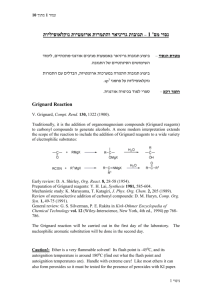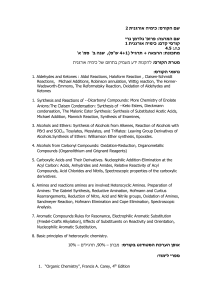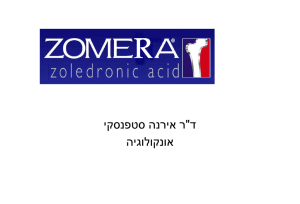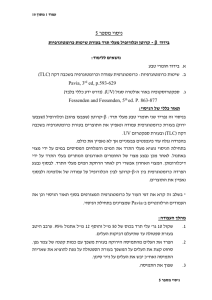ניסוי מספר 3 דחיסות קרבוניליות ומתילנים פעילים
advertisement
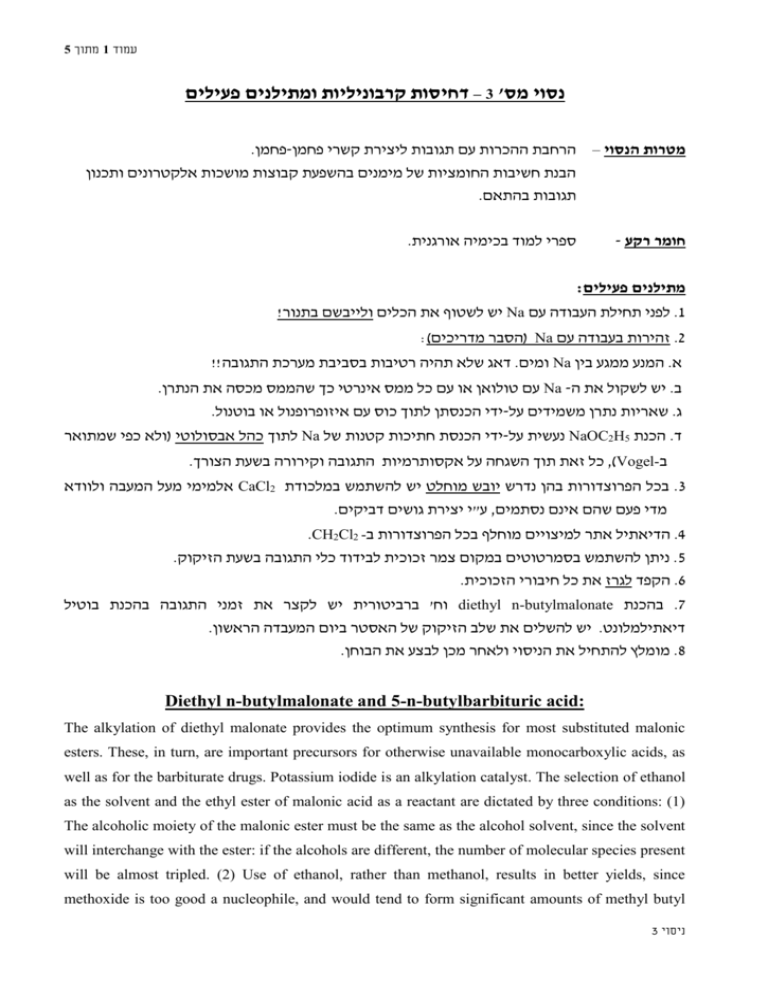
עמוד 1מתוך 5 נסוי מס' – 3דחיסות קרבוניליות ומתילנים פעילים מטרות הנסוי – הרחבת ההכרות עם תגובות ליצירת קשרי פחמן-פחמן. הבנת חשיבות החומציות של מימנים בהשפעת קבוצות מושכות אלקטרונים ותכנון תגובות בהתאם. ספרי למוד בכימיה אורגנית. חומר רקע - מתילנים פעילים: .1לפני תחילת העבודה עם Naיש לשטוף את הכלים ולייבשם בתנור! .2זהירות בעבודה עם ( Naהסבר מדריכים): א .המנע ממגע בין Naומים .דאג שלא תהיה רטיבות בסביבת מערכת התגובה!! ב .יש לשקול את ה Na -עם טולואן או עם כל ממס אינרטי כך שהממס מכסה את הנתרן. ג .שאריות נתרן משמידים על-ידי הכנסתן לתוך כוס עם איזופרופנול או בוטנול. ד .הכנת NaOC2H5נעשית על-ידי הכנסת חתיכות קטנות של Naלתוך כהל אבסולוטי (ולא כפי שמתואר ב ,) Vogel-כל זאת תוך השגחה על אקסותרמיות התגובה וקירורה בשעת הצורך. .3בכל הפרוצדורות בהן נדרש יובש מוחלט יש להשתמש במלכודת CaCl2אלמימי מעל המעבה ולוודא מדי פעם שהם אינם נסתמים ,ע"י יצירת גושים דביקים. .4הדיאתיל אתר למיצויים מוחלף בכל הפרוצדורות ב.CH2Cl2 - . 5ניתן להשתמש בסמרטוטים במקום צמר זכוכית לבידוד כלי התגובה בשעת הזיקוק. .6הקפד לגרז את כל חיבורי הזכוכית. .7בהכנת diethyl n-butylmalonateוח' ברביטורית יש לקצר את זמני התגובה בהכנת בוטיל דיאתילמלונט .יש להשלים את שלב הזיקוק של האסטר ביום המעבדה הראשון. .8מומלץ להתחיל את הניסוי ולאחר מכן לבצע את הבוחן. Diethyl n-butylmalonate and 5-n-butylbarbituric acid: The alkylation of diethyl malonate provides the optimum synthesis for most substituted malonic esters. These, in turn, are important precursors for otherwise unavailable monocarboxylic acids, as well as for the barbiturate drugs. Potassium iodide is an alkylation catalyst. The selection of ethanol )as the solvent and the ethyl ester of malonic acid as a reactant are dictated by three conditions: (1 The alcoholic moiety of the malonic ester must be the same as the alcohol solvent, since the solvent will interchange with the ester: if the alcohols are different, the number of molecular species present will be almost tripled. (2) Use of ethanol, rather than methanol, results in better yields, since methoxide is too good a nucleophile, and would tend to form significant amounts of methyl butyl ניסוי 3 5 מתוך2 עמוד ether, thereby decreasing the amount of butyl halide available to alkylate the malonic ester anion. (3) Higher alcohols dissolve sodium so slowly as to prolong the preparation of alkoxide unduly: this is unfortunate, since some, such as t-butyl alcohol, do not interchange rapidly with dimethyl or diethyl malonate in the presence of alkoxide. The condensation of urea with an alkylmalonic ester results from loss of a proton from urea, followed by nucleophilic attack of the urea anion on the ester. Ring closure occurs when the process is repeated within the same molecule. The alkylbarbituric acid occurs as a series of tautomers, of which one of the two extreme forms (the keto form) is shown on p. 24. Experimental procedure: 1) Diethyl n-butylmalonate In a dry, 250-ml round bottom flask, place 50 ml of dry absolute ethanol and attach a reflux condenser. Weight 2.3 g of sodium in a beaker containing enough inert hydrocarbon, such as ligroin (petrol ether), to completely cover the reactive metal. Transfer it for subdivision to a crystallizing dish containing more of the hydrocarbon. With a knife, cut the sodium under the hydrocarbon into 1/8 to 1/4 inch cubes and add these rapidly, with tongs or forceps, through the condenser (or directly to the flask if done rapidly enough) to the ethanol. The heat of the reaction will keep the alcohol boiling for some time. After most of the sodium is dissolved and ebullition subsided, attach a calcium chloride packed drying tube to the top of the condenser. (Make sure all "T" joints are well greased). Heat the mixture over an oil bath to dissolve the remaining traces of sodium, add 4 g of powdered potassium iodide, and heat to dissolve most of that solid. Afterwards, add 16 ml (17.6 g) of dry diethyl malonate and stir well and heat for 10 minutes. Carefully add 11 ml (14 g) of n-butyl bromide in three equal portions, allowing the reaction to subside after each addition. Heat for 20-30 min. Arrange the equipment for distillation and distil off as much ethanol as possible. Cool the reaction mixture and add 40 ml of water containing 1 ml of concentrated hydrochloric acid. Add 25 ml of ether. Transfer the contents of the flask to a separatory funnel, remove the aqueous layer, and wash the organic layer with a few milliliters of water. Now carefully wash with 25 ml of 5% aqueous sodium bicarbonate solution (there might be gas evolution) and, finally, with 30-40 ml of water. Dry the organic phase over magnesium sulfate, using only the minimum necessary to obtain a clear solution. Filter into a 50-ml round-bottom flask, remove the ether by flash distillation, and then distill under vacuum. The distillation will require care, since foaming may occur. Use an oil bath to avoid overheating the mixture. It is absolutely essential that glass wool insulation or other suitable material of similar insulating power be packed around the upper parts of the distilling flask and 3 ניסוי 5 מתוך3 עמוד round the Claisen head. Collect the distillate boiling at 120-1380C at 25 mm (lit. bp 1361370/21mm). The yield of diethyl n-buthylmalonate is about 12 g. If you have enough time continue to the next step: 5-n-butyl barbituric acid. 2) 5-n-butyl barbituric acid Using the same precautions as observed above, dissolve 0.58 g of sodium in 12.5 ml of dry absolute ethanol in a 100-ml round-bottom flask, add a condenser (well greased at the joints) provided with a calcium chloride packed drying tube, and heat to dissolve the last bits of sodium. Add 5.40 g of diethyl n-butylmalonate, and heat (with stirring) for 10 min. Meanwhile, dissolve 1.5 g of urea in 12.5 ml of boiling absolute ethanol. Take the refluxing diethyl n-butylmalonate assembly off the heating bath. Remove the condenser from the flask and add the hot urea solution all at once to the contents of the flask, and replace the condenser along with its drying tube. A flocculent white precipitate will appear. Heat the contents of the flask carefully at reflux for 30 min. (The reaction must not be left unattended, since violent bumping may occur and the source of heat may have to be readjusted to control this). At the end of the period of refluxing, add 25 ml of hot water to dissolve the solid, then 2.5 ml of concentrated hydrochloric acid. Mix thoroughly, cool in an ice bath, and collect the snow-white solid with suction, washing the solid with a little ice water. Suck the solid dry and allow it to stand open to air at least 24 hours before weighing. The weight of the crude product will probably be greater than 3.3 g: determine its mp (about 2092100C). Recrystallize from boiling water (50 ml/g): if the mixture is allowed to cool slowly to room temperature and chilled after most of the crystallization has taken place, large shiny needles will be obtained. Use charcoal (0.1-0.2 g) for discoloration if the solution is colored. The melting point is 210-2110C (lit. mp 2140C). The recovery of purified 5-n-butylbarbituric acid is about 2.0 g. H O N O N CH3CH2CH2CH2 H H O Diethyl n-buthylmalonate 5-n-buthylbarbituric acid p-Chlorobenzyl alcohol (Cannizzaro reaction) 3 ניסוי 5 מתוך4 עמוד A mixture of p-chlorobenzaldehyde (0.05 mol), formaldehyde (0.13 mol, 30% water solution) and 30 ml of methanol is heated until boiling in a three necked flask equipped with a reflux condenser and a thermometer. The heater is removed and a solution of potassium hydroxide (0.3 mol) in 13 ml of water is added dropwise under intensive stirring at such a rate that the temperature inside the reaction mixture remains 65 – 75OC while cooling with cold water. At the end of addition, the reaction mixture is heated at 70OC for another 40 min and, finally, it is refluxed for 20 min. After cooling, 100 ml of water is added, the product extracted with ether, dried with anhydrous sodium sulfate and evaporated. The product is recrystallized from water. m. p. 72OC. Yield 70%. 1-Dimethylamino-3-phenyl-3-propanone (Mannich reaction) CH3 + H2C O + HNR2 HCl O O NHR2 Cl Acetophenone (0.05 mol), paraformaldehyde (0.1 mol) and dimethylamine hydrochloride (0.05 mol) are refluxed in 10 ml of ethanol during one hour. Concentrated hydrochloric acid (0.1 ml) is added to dissolve unreacted paraformaldehyde. The hot reaction is filtered and evaporated under vacuum. The residue is recrystallized from ethanol. m. p. 156OC. Yield 85%. Trans-4-dimetylamino-4’-nitrostilbene (Perkin Reaction) A mixture of p-nitrophenylacetic acid (9 g), p-dimethylaminobenzaldehyde (7.5 g) and 3 ml of piperidine is heated for 4 hours under reflux in an oil bath maintained at 150O. After removal of volatile material under vacuum, 150 ml of chlorobenzene and 15 ml of petroleum ether (40-60 OC) are added. Heating might be needed to obtain a solution (add the petroleum ether after all the solids are dissolved). After cooling and filtering, 5 g of dark-red crude product (m.p. ~240 OC) is obtained. Further recrystallization from chlorobenzene, filtering and washing shiny red crystals with petroleum ether (40-60 OC) yields 4.5 g of pure product (m.p. 255OC). 9-Benzalfluorene 3 ניסוי 5 מתוך5 עמוד In a 50-ml round-bottom flask, a mixture of 4.15 g (0.025 mol) of fluorene, 0.025 mol of freshly distilled benzaldehyde, 20 ml of benzyl alcohol and 2.0 g of potassium hydroxide are heated at 1000C for 90 min. After cooling, the mixture is transferred to a 500-ml Erlenmeyer and treated with 100 ml of ethanol. The product crystallized slowly and about 0.5 hr must be allowed for complete crystallization (yellowish Crystals). The solid is then filtered and washed with water. The yields of 9-benzalfluorene ranged from 40-70%. 3 ניסוי
